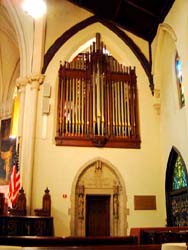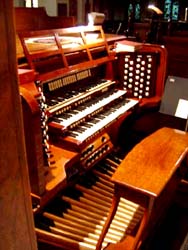Music
A varied and rich musical tradition steeped in Anglican custom
For many people, music is an “incarnational experience” — the appearance of the divine in human form. Music has always played an important role in the spiritual life of Incarnation, evidenced by the church’s history of outstanding organists and music directors, including such names as Charlotte Wells, Edward Shippen-Barnes, Thomas Dunn, Leonard Raver, Jon Gillock, Matthew Lewis and David Ralph. This tradition continues under the direction of Thomas M. Reefer, who was appointed Interim Director of Music in 2022. Mr. Reefer infuses the music program with energy and creativity; he and his all-professional choir are a source of pride for the congregation.
As is the case throughout the history of the Church of the Incarnation, Christmas and Easter remain important sacred and musical celebrations for the parish and the community.
The Choir
Incarnation’s all-professional choir offers a wide variety of music for the Sunday liturgies. Services for the Holy Eucharist feature traditional Mass settings by Haydn, Mozart and Schubert to modern works by Poulenc, Messiaen, along with American music. Morning Prayer Sundays include music of the great Anglican tradition, from Purcell and Byrd to Stanford, Holst, Walton and Britten.
Listen to our choir:
Send Out Your Light:
Laudate Nomen Domini:
Benedictus es Domine
The Organ
The importance of music at Incarnation is evident by the church’s history of outstanding organists and music directors, including such names as Edward Shippen-Barnes, Thomas Dunn, Leonard Raver and Jon Gillock. Unfortunately, records of previous instruments are lost, leaving a sketchy history regarding the first instruments at the church.
A large Roosevelt organ occupied the west gallery along with the choir after the fire of 1882. In 1886, the choir was moved to the chancel, as was the custom for most churches in New York. A new organ was shortly thereafter introduced in the chancel — one organ considerably smaller that the large Roosevelt in the gallery — and the Roosevelt was silent for over a year. Electrical connections were made, and the Roosevelt was once again heard. The new organ in the chancel was built by Hutchings-Votey. It is not known what became of the Roosevelt.
The current three-manual Aeolian-Skinner organ was installed in 1954, retaining some pipework from the existing 1902 Hutchings-Votey organ. Tonal changes were made in 1957.
In 1981, the Schantz Organ Company of Orrville, Ohio, made substantial tonal revisions to the Aeolian-Skinner organ, adding a floating Positiv division and several new ranks of pipes.
Additional work was done in 2000 when the console and relays were rebuilt and updated by the Petty-Madden Organ Company of Hopewell, N.J. In 2009, Petty-Madden restored all of the reeds, and replaced the Swell half-length 16′ Basson with a new 8′ Basson-Hautbois and the Choir Clarinet with a new Cromorne.
Church of the Incarnation Æolian-Skinner Organ
| GREAT | CHOIR | POSITIV (floating) |
| 16′ Quintaton | 16′ Dulciana | 8′ Principal |
| 8′ Montre | 8′ Bourdon | 8′ Flute |
| 8′ Flûte harmonique | 8′ Dulciana | 4′ Prestant (from 8′) |
| 8′ Bourdon | 8′ Voix Celeste | 4′ Bourdon |
| 4′ Prestant | 4′ Principal | 2′ Doublette (from 8′) |
| 4′ Flûte à cheminée | 4′ Flûte traversière | Quinte 1 1/3 |
| 2′ Doublette (from Positiv) | Nazard 2 2/3 | Fourniture III |
| Fourniture III | 2′ Quarte de Nazard | |
| Cymbale III (from Positiv) | Tierce 1 3/5 | |
| 16′ Bombarde (from 8′) | Mixture III | |
| 8′ Trompette | 8′ Cromore | |
| 4′ Clarion (from 8′) | Tremelo | |
| SWELL | PEDAL | |
| 16′ Bourdon | 32′ Soubasse (extension of 16′ Soubasse) |
|
| 8′ Diapason | 16′ Contre Basse | |
| 8′ Gambe | 16′ Soubasse | |
| 8′ Voix Celeste | 16′ Bourdon (Swell) | |
| 8′ Bourdon (from 16′) | 16′ Quintaton (Great) | |
| 4′ Prestant | 8′ Violoncelle | |
| 4′ Flûte Octaviante | 8′ Flûte | |
| 2′ Octavin | 4′ Flûte (from 8′) | |
| Cornet II | 32′ Grand Cornet | |
| Fourniture III | 16′ Bombarde | |
| Cymbale IV | 16′ Trompette (Great) | |
| 8′ Trompette | 8′ Trompette (Great) | |
| 8′ Basson-Hautbois | 4′ Clarion (Great) | |
| 8′ Voix humaine | ||
| 4′ Clairon | ||
| Tremelo |


